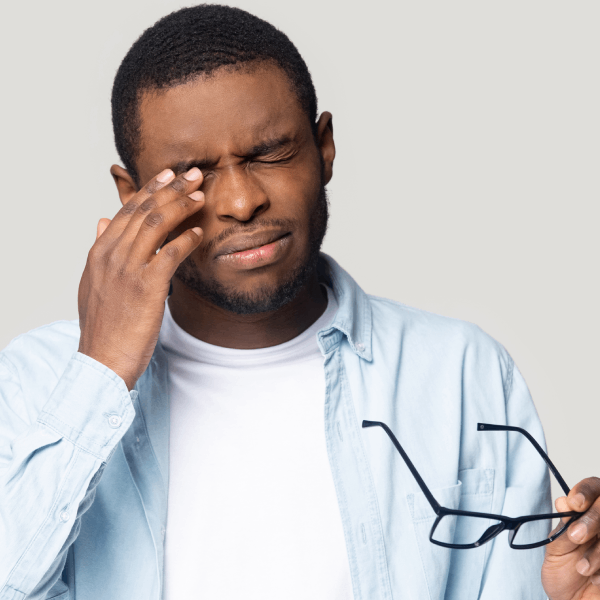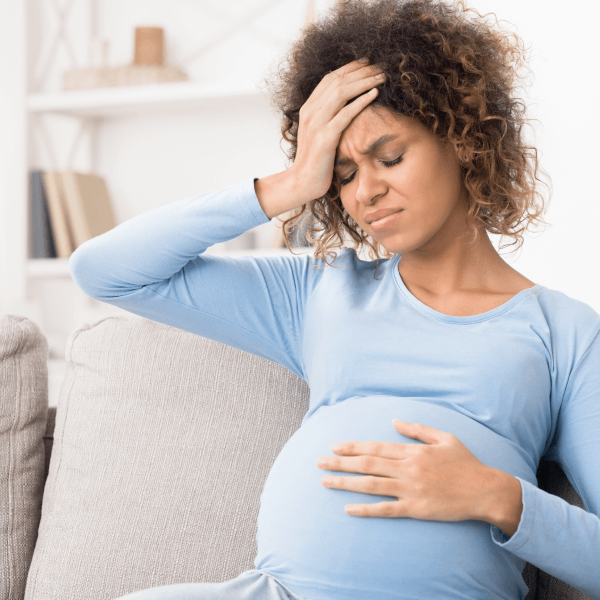Migraine: Symptoms and Causes

Disclaimer: Not medical or professional advice. Always seek the advice of your physician.
Migraine is not just patients' complaints of headaches. It is a hereditary neurological condition, which exhibits a growing pulsating headache. The condition affects several areas at the same time: the cerebral cortex, trunk, and subcortex. This headache may be accompanied by nausea, vomiting, increased sensitivity to light, smell, sound, and physical activity. But it is not related to injuries, tumors, or stroke.
The World Health Organisation's statistics suggest that migraine is one of the leading causes of spontaneous headaches. It is also one of 19 diseases seriously affecting the human being's social adaptation. A migraine attack lasts from several hours to 4 days. Loss of work efficiency that comes with migraine can be felt so badly that the person is considered disabled. Approximately one milliard of people suffers from migraine. Females are 2-3 times more susceptible to it than males and suffer from headaches up to 8 times a month. But males have a higher intensity of pain. Often the disease occurs at a young age, before the age of 20. The problem in diagnostics and treatment of this disease is not fully solved.
Facts about Migraines
- The first symptoms that remind the migraine were first described by ancient healers of the Sumerian civilization's times, even before the birth of Christ in 3000 BC. A little later (about 400 AD), Hippocrates identified migraine as a disease and described its signs.
- Migraine owes its name to the ancient Roman physician - Claudius Galen. He was the first to identify a migraine feature - the localization of pain in one half of the head.
- Migraine is often a companion of geniuses. This disease accompanies active and emotional people who prefer intellectual work. For example, Pontius Pilate, Pyotr Tchaikovsky, Edgar Poe, Karl Marx, Anton Chekhov, Julius Caesar, Sigmund Freud, Darwin, Newton all suffered from migraines.
- Another interesting fact (but it is not yet scientifically proven) is that migraine affects people seeking perfectionism. These personalities are ambitious, and their brain always works. It is not enough to do everything correctly; they should be the best of everyone around them. In fact, these people are workaholics.
Causes of Migraine
Causes of migraines are not yet fully discovered. Scientists found that susceptibility to migraine is inherited through the female line. This is the reason why women suffer from migraines more often than men. The mechanism of pain development during a migraine is not fully discovered. There are several theories about it.
Serotonin, as a Cause of Migraine
Serotonin is a neuromodulator, which causes vasoconstriction. It is required for proper neural signaling. High serotonin levels cause spasms of intracranial blood vessels. These blood vessels do not have pain receptors. Still, when high serotonin levels are present – the body must release the substances to digest them. As a result, blood vessel tonus comes back to the norm. Still, the superficial arteries of the temporal region, which have pain receptors, expand. Dilution of the superficial arteries is the reason for pains. The attack goes away as soon as the serotonin level returns to normal.
Hypothalamus and Migraine
Hypothalamus ensures endocrine system regulation. This brain region contains centers for hunger, thirst, blood vessel tonus. Therefore, attacking headaches during a migraine is related to the hypothalamus and comes as a reaction to external stimuli. According to modern research, migraine attacks occur when increased hypothalamus activity is identified.
Combined Neurovascular Theory (trigeminal-vascular) Theory of Migraine Occurrence
Currently, this is thought to be the leading theory. According to it, a patient has a disrupted connection between the brain's blood vessels and the trigeminal nerve. Under the influence of provoking factors during an attack, the trigeminal nerve is activated. Its endings release strong vasodilators, which decrease the blood vessels' tonus and improve their permeability. This causes edema and swelling of tissues located near the blood vessels. But susceptibility to the migraine can not be manifested itself. People suffering from migraines are sensitive to internal and external factors. They are called triggers/provokers of attacks.
Primary Triggers of Migraines

- Hormonal changes related to blood estrogen levels (menarche, menstruation, ovulation, pregnancy, lactation, use of oral contraceptives, menopause).
- Stress, emotional tension, positive emotions, anxiety, conflicts, inner worries, tight deadlines, relaxation after stress, tension (weekends, beginning of the holiday, vacation, after the exam, etc.).
- Sleep disruption (lack of sleep, excess of sleep, awakening during the night).
- Missing meals.
- Dehydration.
- Alcoholic drinks (often wine, champagne, beer).
- Chilled or canned food, additives, some food products.
- Excess of caffeine.
- Bright light, loud sounds, strong smells.
- Excess of physical exercise, visual stress, incorrect position (staying in one pose for a long time).
- Certain weather conditions.
- Pain in the head area (tooth pain, sinusitis).
Often triggers "work" together. There are uncontrolled triggers, for example, periods, and there are controlled triggers, for example, missing meals or medications. Even when you know all of your triggers, it is impossible to get rid of the migraine attacks fully.
Phases of Migraine Attacks
The migraine attack can be split into phases from the development to the recession. The primary (prodromal) phase is from 2 to 36 hours. The patient becomes irritated, excited, and sensitive to light and sound. He or she notices uncontrolled food cravings, increased urination, thirst, lethargy, tiredness, blurred vision, yawning, drowsiness, blurred speech, destruction of concentration, general weakness, lack of appetite.
Aura (From 5 to 60 Minutes)
Aura is a complex of reversible dysfunctions, which occur before the attack or together with it.
It is characterized by visual, sensory, motor, speech disorders. There is a short interval (no more than 60 minutes) before the end of aura and the beginning of a headache. Many patients claim that their state improves in this time, but they feel detached from reality.
Types of Aura
- Visual. This aura is most frequent. Patients see lines, starting from a small dot, which gradually increases. Later, the dot becomes shinning zigzag-shaped lines, which go from the center to the sides. Patients often feel a partial or full loss of vision. Sometimes patients see pulsating lines around objects and think that their sight is directed through the broken glass. Often it is hard for patients to focus their vision: objects appear lower or higher than they really are. Their color and contours can be distorted. Moreover, sometimes visual hallucinations appear.
- Hemiparesthetic (sensitivity destruction). Patients complain of goosebumps, tingling, and numbness, which then spread to the whole arm. Later, the symptoms go higher, affecting half of the tongue and head.
- Hemiparetic (movement disorders). Weakness appears in an arm or leg on one side.
- Dysphasia (speech disorder). Patients find it hard to find words during the conversation. They feel that they have lost the ability to remember words and cannot make up a sentence. They also feel that they cannot distinguish between letters and numbers.
- Mixed. When several symptoms of two or three types of aura are identified at the same time.
The Phase of Pain Occurs (From 4 To 72 Hours)
This phase can occur after the aura or develop in parallel with it. The pain develops from weak to moderate to strong. During the same attack, pain localization can change. Usually, it appears around the eyes, in the frontotemporal zone. In the beginning, the pain is dull. It gradually develops to pulsating, and its intensity rises. In the end, it becomes constant and strong.
Resolution Phase
After the attack seises, the symptoms of weakness, drowsiness, low concentration, and depression can remain for up to two days. The strength and duration of attacks can be very different in different people and within one person.
Clinical Variation Of Migraine
- Migraine without a headache. This is a type of migraine that only has aura symptoms. Often these patients are suffering from the visual aura. For example, they see flickering, flashes, light zigzags. There is also nausea and/or vomiting and dizziness. Nausea and/or vomiting and dizziness are often present.
- Cyclic migraine. This is a light form of the disease. It is manifested by convulsions with long-term remissions (periods without disease symptoms).
- Hyperprolectic migraine. This is a type of migraine with an aura related to fever during a pain attack.
- Menstrual migraine. It happens due to hormonal changes, which start during the menstrual cycle. Migraine attack in this type of disease is often very strong, long-term and significantly affect daily routine. These types of migraines are resistant to standard treatment.
- Basal migraine. Headaches localized to the back of the head. They are accompanied by speech dysfunction, dizziness, doubled vision, coordination dysfunction, and loss of mobility. This type of migraine usually affects younger people. Basal migraine attacks often alternate with migraine attacks with aura.
- Half migraine. This is a relatively rare type of migraine. The attacks cause temporary sensory-motor dysfunctions on one side of the body and numbness and tingling before the pain.
- Psychiatric migraine. One of the main things about psychiatric migraines is the appearance of many psychological dysfunctions during the attack. The most common psychological symptoms are anxiety, confusion, excessive agitation, hallucinations. This attack usually does not last long (up to a few hours) and returns relatively rarely.
- Retinal migraine. This is characterized by visual impairment on one eye and apparent abnormal blindness, which appears during the migraine attack. Visual impairments and blindness go away after the beginning of the migraine attack. Often these dysfunctions are short (up to 5 minutes) and are accompanied by intense headaches, which can appear after the visual defects are gone.
- Sporadic migraine. This type of migraine is characterized by convulsions that make the person stay in bed. Simultaneously, they are infrequent and only happen once or several times in their lifetime.
- Transformed migraine. It includes the evolution of typical migraine attacks into constant daily headaches. The transformation generally occurs after many years of classical headaches. The factors inducing this type of migraine are overuse of painkillers, ergotamines, triptans, menopause, hypertension, depression.
- Strength migraine. This is a form of the disease when a migraine attack happens only after intensive physical exercises.
Features of Migraine Manifestation in Children and Pregnant women

At a young age, the migraine duration is short — from 30 minutes to a few hours, and the pain is double-sided. It becomes single-sided in the teenage years. Most often, children feel pain in the temples, forehead, periorbital region. The pain type is also not the same as in adults. The pain is squeezing, pounding, a little pulsating. However, children rarely characterize it as pulsating. For the child, it is difficult to talk about their feelings; therefore, the pain intensity is assessed using a visual analog scale with points from 0 to 10. Sometimes rating with smiley faces is used — from smiling to crying.
During pregnancy, migraines can appear even in those who never suffered from them before. In 25% of cases, this is the aura migraine. It feels a lot stronger, and there is nothing to relieve the pain due to the sensitive state. In pregnant, the aura is most frequently manifested by photophobia, isolation, intolerance to sounds and strong odors, extreme nausea, and urge to vomit. Main reasons for pains in pregnant.
- Water deficit in the body.
- Continuous lack of sleep, as it is difficult to sleep with the belly.
- Stress and frequent worries.
- Big weight gain.
- Metabolism destruction.
Complication of Migraine
The migraine itself does not negatively affect the body, but it can induce severe complications and become chronic.
- Chronic migraine. Migraine can be called chronic when it lasts 15 or more days a month. The patient can no longer have a regular active lifestyle. The pain becomes chronic when the use of painkillers is abused.
- Migraine status. It happens when the headache attack lasts for longer than three days, and the pain is unbearable. In migraine status, the pain does not go away with the use of painkillers or rest. It is accompanied by prolonged nausea and vomiting, which often causes dehydration. The state of such patients is severe and often requires hospitalization.
- Migraine stroke. This is one of the most severe complications. It occurs in frequent and prolonged migraines. The brain cells start to die due to a long-term lack of blood in a specific location. Nearly 85% of all patients will notice visual impairment. Amongst them: doubled vision and loss of a specific visual part. In some cases, loss of vision can also be identified.
- Persisting aura. This is a combination of two or more auras together during the migraine attack. This can be manifested by the "bugs" in the eyes, darkness, and bright light flashes. Moreover, in some cases, there are visual hallucinations. After the migraine attack with aura, patients often describe or even draw them to show their doctor.
- Convulsion attack. Another severe complication of the migraine. It can appear when the patient does not stop vomiting for a long time due to the migraine. The patient loses a large amount of liquid with vomit. Dehydration induces convulsions.
Migraine Prognosis
There is mainly a favorable prognosis for migraine, apart from some rare cases when there is a possibility of developing complications (migraine status or migraine stroke).
For the migraine not to become chronic, the patient has prescribed treatment. The prophylaxis treatment is individual for each patient taking into account all provoking facts and emotional-personal dysfunctions.
Clinical Researches of Migraine
Our clinic, Visionaries Clinical Research, conducts a study about the Migraine. For making the decision, you should consider the following.
- You can quit the study at any point.
- The research group will explain all possible advantages and risks of the investigation when receiving informed consent.
- You do not have to participate in the study if you do not want to.
- A team of doctors and nurses will carefully watch your health during the study.
- Studied drugs and placebos are provided at no extra cost.
- Your participation helps developing treatments for other people with migraines.
If you are ready to participate in the clinical study, please, contact our clinic to get more detailed information or fill in the form on our website.
Sign Up to Be a Volunteer